Table of contents
- Spotlight on motorcycle production, part 3: BMW Berlin motorcycle works
- Location with tradition
- Overview of three manufacturers
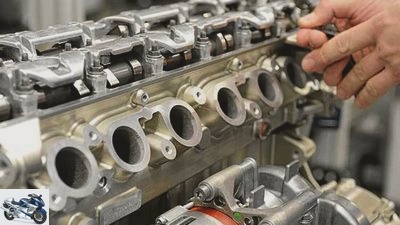
Bilski
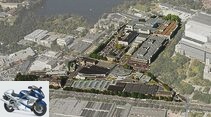
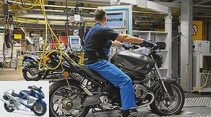

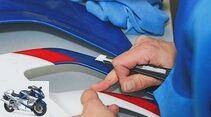
13th pictures
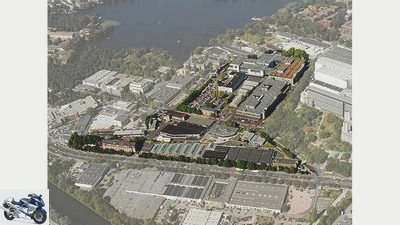
Bilski
1/13
A location with tradition – the oldest halls of the Spandau plant have been in existence since 1928, and since 1939 it has belonged to BMW.
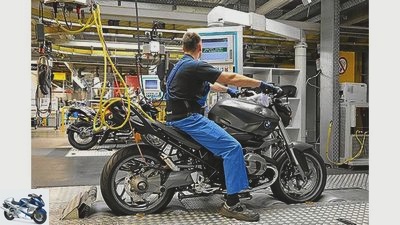
Bilski
2/13
During the test run, the technical features of each motorcycle are recorded and checked. With ABS alone, this affects over 100 parameters.
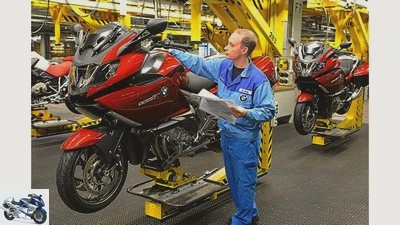
Bilski
3/13
When the motorcycles have passed the technical test, they are completed on four final assembly lines. The K 1600 receives its voluminous panels and cases here, the R 1200 R in the small picture the holder for the optionally available windshield.
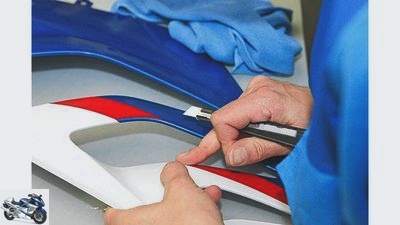
Bilski
4/13
The right side of the fairing of an S 1000 RR in the racing color sample. The red colored areas are glued on by hand, followed by a layer of clear varnish.
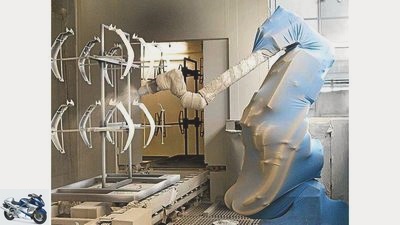
Bilski
5/13
This painting robot uses static electricity to prime plastic parts. He paints each type with a different choreography. He regularly cleans his spray nozzle and replenishes his paint supply.

Bilski
6/13
One of the three basic assembly lines is reserved for the K models with four and six-cylinder engines. The motorcycles are assembled here together with individual accessories until they are ready to drive.
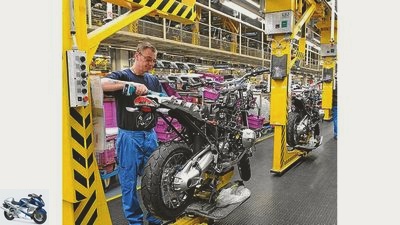
Bilski
7/13
Because they have no lavish cladding, the R 1200 GS and R can be almost completely completed on the basic assembly line. Individual pieces of equipment are scanned and compared with the order.

Bilski
8/13
The mechanic first gently tightens the connecting rod bolts of the S 1000 engine by hand so that the connecting rod feet fit together neatly. For tightening, he uses a processor-controlled double screwdriver.
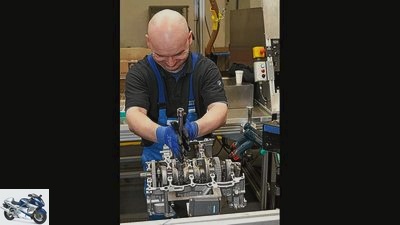
Bilski
9/13
The mechanic first gently tightens the connecting rod bolts of the S 1000 engine by hand so that the connecting rod feet fit together neatly. For tightening, he uses a processor-controlled double screwdriver.
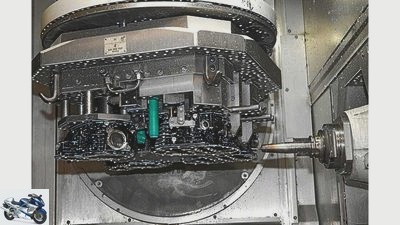
Bilski
10/13
Four boxer cylinder heads are milled and drilled in this machining center. Then they get valve seats, guides and studs.

Bilski
11/13
The complex steel frames of the R series are welded both by robots and manually. The latter mainly affects the numerous owners.
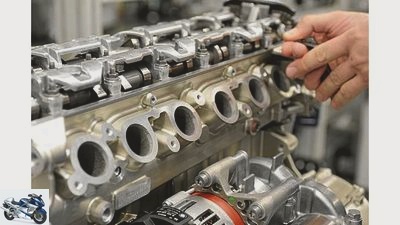
Bilski
12/13
The third and last part of the series on motorcycle production is about the BMW plant in Berlin and introduces two new aspects: engine production and dealing with a diverse range of special equipment.

Bilski
13/13
BMW sends the finished bikes in reusable steel frames to Germany and other European countries. For long-distance travel they come in cardboard boxes on wooden racks.
counselor
workshop
Spotlight on motorcycle production, part 3: BMW
Spotlight on motorcycle production, part 3: BMW
Berlin motorcycle works
The third and last part of the series on motorcycle production is about the BMW plant in Berlin and introduces two new aspects: engine production and dealing with a diverse range of special equipment.
Ralf Schneider
03/03/2011
One of the most modern branches of production, in fact the heart of the BMW motorcycle factory in Berlin-Spandau, is mechanical production. This is where the most important parts of the double-cam boxer, the 200 hp four-cylinder of the S 1000 RR and the brand new six-cylinder are made. But the high-precision machining centers, millions of machines with state-of-the-art technology, are located in listed halls. “If we want to set up a new machine here and enlarge a wall opening to do this, we have to build the wall back to the original stone by stone”, tells Dr. Stefan Kasperowski, the head of the department. He says this with a certain pride, in no way does it give the impression that this effort is a nuisance to him. Apparently he feels like the visitor, who sees the beginning of a long tradition and its very latest form aptly symbolized in one and the same building complex.
Buy complete article

Spotlight on motorcycle production, part 3: BMW
Berlin motorcycle works
6 pages) as PDF
€ 2.00
Buy now
A prosperous coexistence of new and old also prevails in the production strategies. Processor-controlled automation in all varieties and manual work are pragmatically combined. In this respect, BMW is no different from Honda and not even from Bimota, where the parts, which are assembled entirely by hand, are also made by machine by suppliers. What the three different motorcycle production sites also have in common is that more manual work is done there than in the automotive industry, where much higher quantities are in demand.
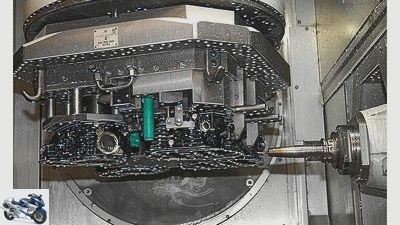
Bilski
Four boxer cylinder heads are milled and drilled in this machining center. Then they get valve seats, guides and studs.
In the historic halls, a machining center rubs and mills the valve guides and seats of an S 1000 RR engine with just one tool with a tolerance of a maximum of 4 thousandths of a millimeter. At the same time, opposite, in the engine assembly hall, the valve clearance values of an almost completed K 1600 six-cylinder are measured by hand with a feeler gauge. Or the connecting rod feet and bolts of another S 1000 engine are carefully attached to one another with an extension and a Torx insert before an automatic twin screwdriver finally tightens them to a basic torque and with a uniform angle of rotation. The mechanics themselves introduced the intermediate step when they discovered that fitting problems can arise if the individual fracture structure of each connecting rod is too flat and the screws are tightened quickly.
In the paint shop, robots, wrapped in elastic jerseys to protect their mechanics from paint mist, perform complicated sprayer choreographies before the freshly sprayed parts go through the drying procedure. At the same time, lacquered parts are provided with adhesive decorations by hand at 20 workstations or partially masked with adhesive tape according to precisely specified patterns and thus prepared for a second layer of clear lacquer or another color. Color schemes such as the white-blue-red racing paintwork of the S 1000 RR even need three passes: First the trim parts are painted white, then blue after masking and finally after the red decorative stripes have been applied with clear varnish. It is understandable that this effort also costs an extra charge.

Bilski
Because they do not have lavish cladding, the R 1200 GS and R can be almost completely completed on the basic assembly line. Individual pieces of equipment are scanned and compared with the order.
In all departments, their heads tell about the latest improvements in the production process that they have developed with their employees. When production was cut back in the crisis year 2009, the mechanical production workers used the free time and played through new arrangements and processes with cardboard boxes and empty lattice boxes that were supposed to represent machine tools. In the end, they had developed a process that saves a quarter of the throughput time in cylinder head machining. In the engine assembly or on the individual production lines, all the necessary small parts, screws, nuts, clamps and seals are spread out like in a supermarket. The arrangement of this supermarket differs from department to department. Sometimes sorted in rows according to the sequence of operations, sometimes presented in a U-shape, but always in the way those who think it is optimal who have to deal with it on a daily basis. Everyone is called upon and invited to take part in a permanent and very detailed optimization process. When comparing the motorcycle factories of BMW and Honda, an important difference is noticeable here: a process whose functionality has been proven is immediately viewed critically again at BMW and respected at Honda. That doesn’t rule out leaving some things the same at BMW and doing a lot new at Honda, but it does show a completely different basic attitude.
Another unique selling point of BMW requires complicated logistics: the possibility of having every motorcycle equipped with a variety of special accessories and special equipment, depending on your wishes and budget. Customers can change their selection up to three days before assembly. Then the respective specification must be defined in the system. The various models of the K, R and S series are then assembled on three basic assembly lines with the already famous yellow L-beams until they are ready to drive. Which does not mean that they are already complete, although most of the individual equipment features are already on board at this stage. The allocation to the three bands is not strictly separated according to series. It is true that all K-BMWs, regardless of whether they are 1300 or 1600, are produced on one production line; that makes sense because of the similarities. The boxer models, however, are distributed over two lines, with the elaborately disguised RT and its official version with the fully disguised super athlete S 1000 RR running off the same line. The more economical connected GS and R variants share the third. All F 800 and G 650 GS are produced on so-called flex belts, which are not classic assembly lines, but rather rolling girders that are pushed from station to station.

Bilski
BMW sends the finished bikes in reusable steel frames to Germany and other European countries. For long-distance travel they come in cardboard boxes on wooden racks.
At this stage, when the components are still relatively easy to access and, if necessary, to be replaced, all motorcycles go through an extensive function test. Over 100 parameters are checked for ABS alone. The machines are then distributed over four final assembly lines, whereby the time required for final assembly is sorted. An R 1200 only has a seat and side cover there. “The most complex are the government vehicles with radios, sirens, flashing lights and all kinds of equipment. In extreme cases, they can spend up to three hours here. This is high school”, says Franz-Xaver Burgmaier, head of this department. “That’s why our best people work there. You have to master a long sequence of work steps.”
Battery care is an important thing both before assembly and between completion and shipping. ABS, electronic driving aids and the bus system, which sometimes allows high quiescent currents to flow, do not function below the defined minimum voltage; batteries are recharged accordingly often.
On the way to shipping, the MOTORRAD delegation happened to get an idea of how much preparation time it would take to set up the production facility for a new model. A cloth-covered machine that was pushed out of a hall turned out to be a large scooter like the in a short gust of wind “Concept C”, last fall as “Design study” presented. Well, this design study will probably go into series production after the factory holidays in August 2011.
Location with tradition
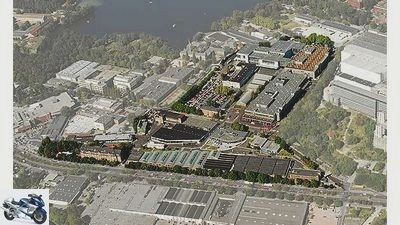
Bilski
A location with tradition – the oldest halls of the Spandau plant have been in existence since 1928, and since 1939 it has belonged to BMW.
The oldest halls of the Spandau plant have been in existence since 1928, and since 1939 it has belonged to BMW. But it wasn’t until 1969, with the newly developed / 5 series, that the Bavarians began to produce motorcycles there. At that time, the capacities in Munich were needed for automobile production, and there were also substantial investment allowances to keep the enclosed city of Berlin alive economically. Ultimately, they helped BMW not to give up motorcycle production despite the sluggish market at the time. Today, around 1,600 workers in the Berlin plant build around 100,000 motorcycles a year, up to 550 a day. The workforce compensates for seasonal fluctuations through flexible shift work and working time accounts. In 2010, BMW invested 35 million euros in expanding the plant.
Overview of three manufacturers
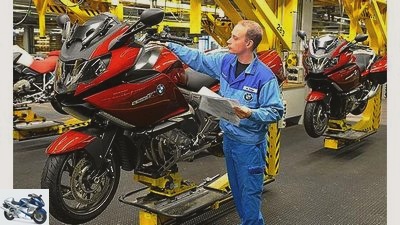
Bilski
When the motorcycles have passed the technical test, they are completed on four final assembly lines. The K 1600 receives its voluminous panels and cases here, the R 1200 R in the small picture the holder for the optionally available windshield.
MOTORRAD presented the production facilities of three manufacturers. Finally, a comparison of facts and figures.
Motorcycle production can take many different forms. In addition to the sometimes enormous differences, what was particularly fascinating about the factory visits was how the current situation of the respective manufacturer was reflected in the activities on site. Honda is acting very cautiously in the face of falling market shares, Bimota is fighting for survival and BMW is investing and expanding. In addition to numerous new models, the Bavarians are relying more than ever on an extensive range of individually selectable special equipment.
All that’s missing is a report about the heart of Honda production: the new plant in Kumamoto, Japan. The request is running.
| manufacturer | BIMOTA (Rimini / Italy) |
BMW (Berlin) |
HONDA (Atessa / Italy) |
founding year | 1973 | 1939 | 1971 |
| employees in total/ Motorcycle area |
25/25 | approx. 1900/ approx. 1630 | approx. 700/ approx. 700 | Working time regulation | Single shift operation | Two-shift operation / Working time accounts |
Single shift operation |
| motorcycle- Annual production 2010 |
approx. 190 units | 97076 units | 40000 Units and 70000 Scooter | Total motorcycle capacity | approx. 600 units | approx. 130000 units | approx. 66000 Units and 132,000 Scooter |
| Production segments | Development, testing and assembly | Development of production processes, mechanical production, engine assembly, frame construction, Tank manufacturing, Painting, assembly |
Development of production processes, scooter motor construction, frame construction, Tank production, painting, assembly |
Number of models | 6th | 17th | 9 Motorcycle and 5 Scooter models |
| other activities | Tests on behalf of other manufacturers | Brake discs- production for BMW cars |
Aggregate engine construction |
Related articles
-
Motorcycle production, part 1: Honda
Jahn 15th pictures Jahn 1/15 How are motorcycles produced? Where do the parts come from, what happens before final assembly? These questions urged…
-
Motorcycle production at Bimota
Jahn counselor traffic & business Motorcycle production at Bimota This is how one of the smallest manufacturers in the world produces Motorcycle…
-
The little ABC of motorcycle types, part two, E ?? H
Harley-Davidson motorcycles The little ABC of motorcycle types, part two, E ?? H The little ABC of motorcycle types, part two, E ?? H VSOP 850 FLHRSI…
-
The small ABC of motorcycle types, part 1 A ?? D.
Buell motorcycles The small ABC of motorcycle types, part 1 A ?? D. The small ABC of motorcycle types, part 1 A ?? D. ETV 1000 XB9R S4R Manufacturers…
-
MOTORCYCLE comparison test Alpen-Masters 2014 part 2
jkuenstle.de 116 pictures fact, jkuenstle.de 1/116 The extreme seating position was also not ideal for the test track. fact, jkuenstle.de 2/116 However,…
-
Motorcycle production country Thailand: Ducatis now also from Thailand?
Ducati counselor traffic & business Motorcycle production country Thailand: Ducatis now also from Thailand? Thailand is the number 5 motorcycle…
-
Michael Martin’s Motorcycle Adventure, Part 4: Australia
Michael Martin to travel Michael Martin’s Motorcycle Adventure, Part 4: Australia Michael Martin’s motorcycle adventure Slope dreams in Australia…
-
Michael Martin’s Motorcycle Adventure, Part 7: Winter on the Dempster Highway
Michael Martin to travel Michael Martin’s Motorcycle Adventure, Part 7: Winter on the Dempster Highway Michael Martin’s Motorcycle Adventure, Part 7:…
-
Motorcycle tour Panamericana part 1
Army car 27 pictures Army car 1/27 A MOTORRAD volunteer fulfills a lifelong dream: from Alaska to California on a motorcycle. Army car 2/27 Pure nature:…
-
The small ABC of motorcycle types, part 3 K ?? Y
Yamaha motorcycles The small ABC of motorcycle types, part 3 K ?? Y The small ABC of motorcycle types, part 3 K ?? Y No X in front of a U Why are Z, X…